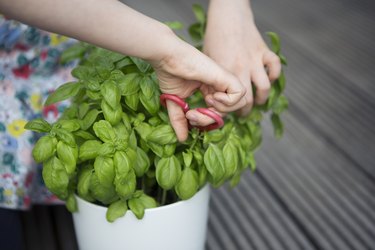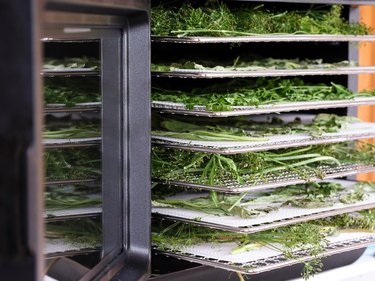
One of the most flavorful and aromatic of the homegrown annual herbs, sweet basil (Ocimum basilicum) is one of the simplest to dry and store. Basil grows easily outdoors or inside on a sunny windowsill, making it simple to pinch and use fresh, but when the crop is abundant, it's time to dry the leaves.
When to Harvest Basil
Video of the Day
You'll find the strongest and best flavor in your basil leaves if you harvest them right before the buds open into flowers. This will give you an abundance of mature leaves filled with aromatic oils. Harvest the leaves in the middle of the morning — while the soil is still moist from watering but after the sun has dried the leaves.
Video of the Day
How to Harvest the Leaves
Cut the whole plant stem free and bring it to your work area. You can harvest up to about three-quarters of a season's growth in a single session. Use a pair of sharp kitchen shears to snip off each individual leaf from the central stem. Leave a short stem on each leaf, no more than 1 inch long. Rinse the leaves gently in a bowl of cold water to remove soil and chemicals; then pat them dry between two paper towels. Removing this excess moisture will help to prevent mold while the leaves are drying.
Air-Drying the Basil
Bundle a handful of basil leaves with their stems together. Wrap the stems tightly with a twist tie to hold them together in one bunch. Make more than one bundle if you have a lot of leaves to dry.
Hang the bundles on a hook or thumbtack in a brightly lit room with good air circulation. Your kitchen is a good place, as are covered porches and airy family rooms. Make sure you can open the windows occasionally to get a breeze in the room.
Let the basil hang for two weeks before checking. If the leaves are dry and brittle, remove them from the hooks and crumble the leaves into a small jar for storage. If the leaves are still slightly flexible, allow them to dry for at least one more week until they are completely dry.

Basil Quick-Dry Methods
Harvest, clean and dry the leaves the same way you would if you were air-drying your herbs. If you want to dry your leaves in a food dehydrator, set the machine according to the manufacturer's directions. Spread the leaves on the dehydrator tray in a single layer. Dry the leaves for two to 48 hours until they are completely dry and crumbly.
For an even quicker drying session without any special equipment, use your home oven to prepare your basil leaf harvest. Place the leaves on a cookie sheet or pizza pan and preheat the oven to the lowest setting possible, 200 degrees Fahrenheit on most American ovens. Place the pan of leaves in the preheated oven and bake them for 20 minutes. Turn off the oven, but don't open the door.
Allow the leaves and pan to cool overnight without disturbing them. They should be crumbly and dry by morning. If they're still flexible, repeat the process one more night.
The fastest way to dry basil leaves is by using a microwave oven, but it's really only a valid method for a small amount of leaves. Spread the leaves out in a single layer on a microwave-safe dish. Heat them on high for one minute. Turn the leaves over; then continue heating them in 30-second intervals until they are dry and crumbly.
Storing Dried Basil Leaves
Like other dried herbs, basil lasts the longest when stored in a cool, dark place and kept in an airtight container when not in use. You can also place the leaves in small jars with tight-fitting lids or small plastic storage containers. Small leftover jam jars are an ideal recycled option.
After being stored for some months, dried basil won't spoil, but it may lose its flavor and potency. Check the strength of your leaves by crushing a pinch between your fingers and then smelling and tasting it. If the odor and flavor are weak, it's time to discard it and dry another batch.